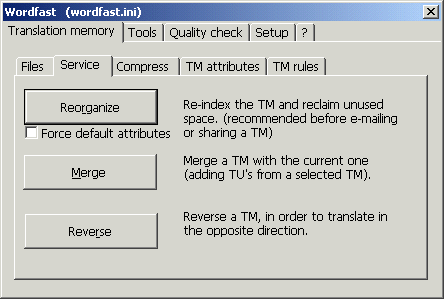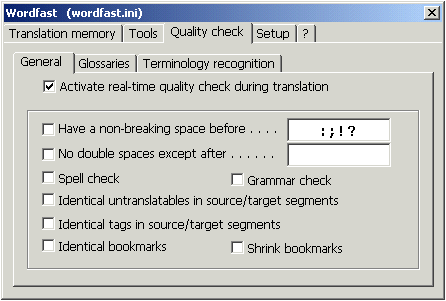30 - Wordfast functions - second part
«Once the abstractly expressed and unserviceable dream-thought is translated into pictorial language,»1.
The Service menu of the Translation Memory frame in the Wordfast icon looks like this:

The more important functions concern the Merge option, useful for uniting two translation memories used in distinct sessions and/or computers into a single translation memory. Using the Merge function, of all the segments that are double (present in both memories) only one occurrence is retained.
Another very interesting function is Reverse. We have seen that while you're creating a translation memory, you must state the linguistic combination you're about to use, for example, to translate from U.S. English into Italian, you input EN-US IT-IT. That prevents using the same data in the memory when you translate in the opposite sense, i.e. from Italian into U.S. English. If you try to do it, the program never suggests any solution because it could never find any resemblance between the prototext segments in the memory (in English) and the prototext segment to be translated (in Italian).
Thanks to the Reverse function, the translation memory is "reversed", and the prototext and metatext languages are swapped: in this way you can use it to translate from IT-IT into EN-US. Such function is particularly important if you think that translation abilities, brain paths activated for a given linguistic combination do not always coincide with those of other linguistic combinations. For this reason the translator used to work from English into Italian has already many predefined paths that make the work quicker, that, however, are not always usable when working in the opposite direction. With the suggestions of the "reversed" Wordfast memory, such procedure is greatly encouraged.
Translation memory attributes. From the Wordfast menu you can access the "TM attributes" option, that opens a frame that looks like the one shown here:

From here you can attribute features to a translation memory that eventually are used to validate or eliminate given translation possibilities. The first feature is mandatory and permanently constant and concerns the translator's ID. Usually, the second one concerns the subject and the third one the client, and for the other two there is plenty of liberty.
Having set the attributes, you can set penalties according to given parameters. For example, if I'm working with a group of translators, I can decide that the less experienced ones (who the translator is is understood from the first line of attributes) deserve a 5 point penalty (i.e. their translation choices are less reliable than the ones of the more experienced translators). This hierarchy is reflected when with the Merge function you unify the translation memories from the different translators to create one more extended and richer memory.
Thanks to the 5 points penalty, every time the translation memory proposes a solution coming from the less experienced translators, such proposal doesn't appear on a light green background (and therefore I know that I have to be careful before accepting the suggestion).
Translation memory rules. These are rules applied every time a translation unit is used, or modified, after the program had already proposed it as 100% match. In fact, every time in the lower frame a Wordfast proposal appears, among the program's control codes there is also the percentage of match with a pair of previously translated segments. When the percentage is 100, this in principle means that the match is absolute, therefore usually you shouldn't need to edit it before accepting it. But sometimes it is not so: the translated segment could have been fit in a different situation and no longer be so, for various reasons connected to the context.
How should Wordfast behave when the translator edits a string that has a 100% match?

In the Editing an existing TU frame, the program offers four possibilities:
Add to TM by overwriting the existing TU: this option is good for people thinking that the more recent choice must predominate over the previous ones. The software, every time you edit a segment translating the same prototext segment, it deletes the previous version substituting the newer one.
Add to TM; overwrite existing TU if attributes are identical: With this option, the erasure of the oldest version occurs only if the memory attributes (translator, client, subject etc.) are the same. In other cases, both versions are preserved, with different attributes.
Add to TM; do not overwrite existing TU: with this option you preserve both versions of a segment: if, for example, I translate the sentence "I'm hungry" once as "ho fame", the next one as "ho appetito", the other one as "mangiamo?", once as "a che ora si mangia oggi?", the translation memory preserves all the four versions and proposes them each time I find the string "I'm hungry". This option is not advisable because, obviously, it creates a lot of redundancy in the work.
Do not add to TM: With this option, the version proposed by the translator is not stored: the memory preserves only the previously present version.
If Wordfast has more than one proposal for the same prototext segment, the matching value (percentage) is in dark blue preceded by the + sign. If you press Alt-Left, a frame opens containing all the matches found and the corresponding attributes. To pass from a solution to the other one, press Alt-Left or Alt-Right. The first solution proposed by Wordfast is the more recently used.
Quality control. One of the Wordfast menu options is called "Quality check" and concerns functions that can be activated to check the text once it is translated.

Here are some of the possible options:
No double spaces except after. With this option, quality check eliminates all double spaces (very frequent mistake). If you wish, you can preserve double spaces only after given strings, to be indicated in the appropriate frame.
Spell Check. With this option you activate Word's spell check. It is important to check that the parts of the texts in the different languages are marked by Word in their corresponding languages, so that the correct spelling check is used.
Identical untranslatables. With this option, Wordfast checks that the parts not to be translated (to be copied as they are) are really identical in the prototext and in the metatext. Usually the program considers as untranslatable strings containing numbers.
In the next unit we will go on with the overview of Wordfast functions.
Bibliographical references
FREUD SIGMUND, L'interpretazione dei sogni, in Opere, vol. 3, Torino, Boringhieri, a cura di C. L. Musatti, 1966.
FREUD SIGMUND, The Interpretation Of Dreams, translated by A. A. Brill, London, G. Allen & company, 1913.
CHAMPOLLION YVES Wordfast, available in the world wide web at the address www.wordfast.org, consulted 23 May 2004.
1 Freud 1900: 308.



